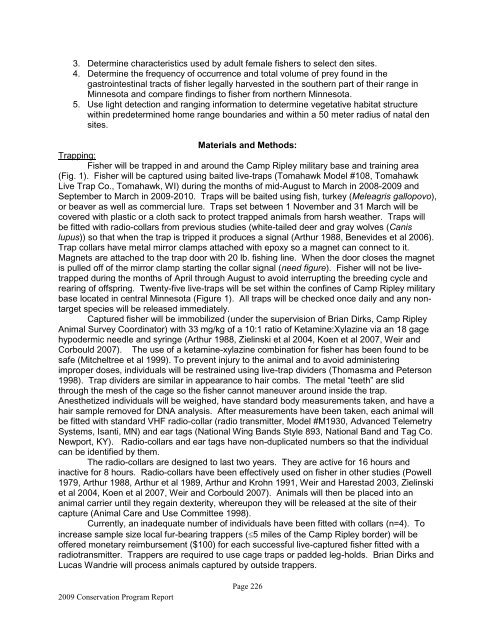camp ripley and arden hills minnesota army national guard training ...
camp ripley and arden hills minnesota army national guard training ...
camp ripley and arden hills minnesota army national guard training ...
You also want an ePaper? Increase the reach of your titles
YUMPU automatically turns print PDFs into web optimized ePapers that Google loves.
3. Determine characteristics used by adult female fishers to select den sites.<br />
4. Determine the frequency of occurrence <strong>and</strong> total volume of prey found in the<br />
gastrointestinal tracts of fisher legally harvested in the southern part of their range in<br />
Minnesota <strong>and</strong> compare findings to fisher from northern Minnesota.<br />
5. Use light detection <strong>and</strong> ranging information to determine vegetative habitat structure<br />
within predetermined home range boundaries <strong>and</strong> within a 50 meter radius of natal den<br />
sites.<br />
Materials <strong>and</strong> Methods:<br />
Trapping:<br />
Fisher will be trapped in <strong>and</strong> around the Camp Ripley military base <strong>and</strong> <strong>training</strong> area<br />
(Fig. 1). Fisher will be captured using baited live-traps (Tomahawk Model #108, Tomahawk<br />
Live Trap Co., Tomahawk, WI) during the months of mid-August to March in 2008-2009 <strong>and</strong><br />
September to March in 2009-2010. Traps will be baited using fish, turkey (Meleagris gallopovo),<br />
or beaver as well as commercial lure. Traps set between 1 November <strong>and</strong> 31 March will be<br />
covered with plastic or a cloth sack to protect trapped animals from harsh weather. Traps will<br />
be fitted with radio-collars from previous studies (white-tailed deer <strong>and</strong> gray wolves (Canis<br />
lupus)) so that when the trap is tripped it produces a signal (Arthur 1988, Benevides et al 2006).<br />
Trap collars have metal mirror clamps attached with epoxy so a magnet can connect to it.<br />
Magnets are attached to the trap door with 20 lb. fishing line. When the door closes the magnet<br />
is pulled off of the mirror clamp starting the collar signal (need figure). Fisher will not be livetrapped<br />
during the months of April through August to avoid interrupting the breeding cycle <strong>and</strong><br />
rearing of offspring. Twenty-five live-traps will be set within the confines of Camp Ripley military<br />
base located in central Minnesota (Figure 1). All traps will be checked once daily <strong>and</strong> any nontarget<br />
species will be released immediately.<br />
Captured fisher will be immobilized (under the supervision of Brian Dirks, Camp Ripley<br />
Animal Survey Coordinator) with 33 mg/kg of a 10:1 ratio of Ketamine:Xylazine via an 18 gage<br />
hypodermic needle <strong>and</strong> syringe (Arthur 1988, Zielinski et al 2004, Koen et al 2007, Weir <strong>and</strong><br />
Corbould 2007). The use of a ketamine-xylazine combination for fisher has been found to be<br />
safe (Mitcheltree et al 1999). To prevent injury to the animal <strong>and</strong> to avoid administering<br />
improper doses, individuals will be restrained using live-trap dividers (Thomasma <strong>and</strong> Peterson<br />
1998). Trap dividers are similar in appearance to hair combs. The metal “teeth” are slid<br />
through the mesh of the cage so the fisher cannot maneuver around inside the trap.<br />
Anesthetized individuals will be weighed, have st<strong>and</strong>ard body measurements taken, <strong>and</strong> have a<br />
hair sample removed for DNA analysis. After measurements have been taken, each animal will<br />
be fitted with st<strong>and</strong>ard VHF radio-collar (radio transmitter, Model #M1930, Advanced Telemetry<br />
Systems, Isanti, MN) <strong>and</strong> ear tags (National Wing B<strong>and</strong>s Style 893, National B<strong>and</strong> <strong>and</strong> Tag Co.<br />
Newport, KY). Radio-collars <strong>and</strong> ear tags have non-duplicated numbers so that the individual<br />
can be identified by them.<br />
The radio-collars are designed to last two years. They are active for 16 hours <strong>and</strong><br />
inactive for 8 hours. Radio-collars have been effectively used on fisher in other studies (Powell<br />
1979, Arthur 1988, Arthur et al 1989, Arthur <strong>and</strong> Krohn 1991, Weir <strong>and</strong> Harestad 2003, Zielinski<br />
et al 2004, Koen et al 2007, Weir <strong>and</strong> Corbould 2007). Animals will then be placed into an<br />
animal carrier until they regain dexterity, whereupon they will be released at the site of their<br />
capture (Animal Care <strong>and</strong> Use Committee 1998).<br />
Currently, an inadequate number of individuals have been fitted with collars (n=4). To<br />
increase sample size local fur-bearing trappers ( 5 miles of the Camp Ripley border) will be<br />
offered monetary reimbursement ($100) for each successful live-captured fisher fitted with a<br />
radiotransmitter. Trappers are required to use cage traps or padded leg-holds. Brian Dirks <strong>and</strong><br />
Lucas W<strong>and</strong>rie will process animals captured by outside trappers.<br />
2009 Conservation Program Report<br />
Page 226
















